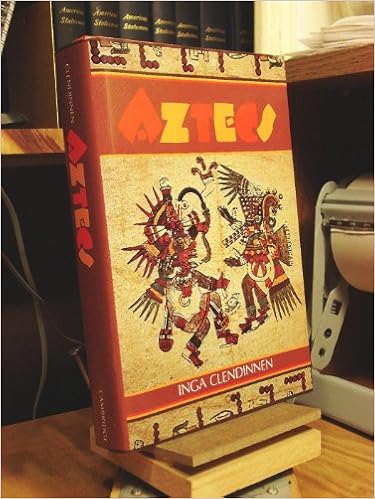
Free Downloads Aztecs: An Interpretation

Inga Clendinnen creates a vivid and dramatic picture of life in the Aztec city of Tenochtitlan, once the nerve centre of the Aztec tribute empire. She explores the worlds of Aztec women, of priests and of warriors, in an extraordinary recreation of everyday life in the city. Contrasting the beauty and sophistication of Aztec culture with the savagery of human sacrifice, she attempts to explain the philosophy, rituals, and social structures that underpinned this remarkable empire.

Hardcover: 414 pages
Publisher: Cambridge University Press; First Edition edition (August 30, 1991)
Language: English
ISBN-10: 0521400937
ISBN-13: 978-0521400930
Product Dimensions: 6.3 x 1.2 x 8 inches
Shipping Weight: 1.6 pounds
Average Customer Review: 4.2 out of 5 stars See all reviews (13 customer reviews)
Best Sellers Rank: #627,102 in Books (See Top 100 in Books) #84 in Books > History > Ancient Civilizations > Aztec #578 in Books > History > Americas > Mexico #2115 in Books > History > Americas > Native American

This book is an exercise in Ethnohistory, attempting to describe a society that ceased to exist about 500 years ago. It is written to give mainly non-specialist readers an insight into the minds of all the Mexica, the people of the capital of the Aztec empire, Tenochtitlan, not just its ruling elite. It claims to be innovative in its focus (concentrating on the people’s religious rituals), in its use of sources, and in its style as a series of essays. As there are very few credible sources for the early history of the Mexica, it can only describe the society of the few decades of the late 15th and early 16th centuries before the Spanish conquest. However, as that empire had risen rapidly in less than a century from a small island settlement, that may not be a major limitation.In her Introduction and note on sources, Inga Clendinnen stresses that she is ignoring the focus of other authors on the rise of Tenochtitlan, state formation, economic and social organisation and official religious practices in favour of trying to understand Mexica religious beliefs and social attitudes on an emotional level. These two sections are rather full of sociological jargon, and are probably the weakest parts of the book. The rest of the book is an interesting read: despite its declared intention, it is perhaps less innovative than the author claims.Clendinnen relies very heavily on a single source, the Florentine Codex. Although this was edited by a Spanish friar in colonial times, she claims that its description of life in Tenochtitlan in Aztec times allowed her to gain access to Mexica voices and actions, because its editor did not impose his views on his informants too strongly.
Aztecs: An Interpretation (Canto Classics) Aztecs: An Interpretation Biopsy Interpretation of the Gastrointestinal Tract Mucosa: Volume 1: Non-Neoplastic (Biopsy Interpretation Series) Biopsy Interpretation of the Gastrointestinal Tract Mucosa: Volume 2: Neoplastic (Biopsy Interpretation Series) Personal Umbrella Coverage Guide - Interpretation and Analysis: Interpretation and Analysis Wiley Not-for-Profit GAAP 2014: Interpretation and Application of Generally Accepted Accounting Principles (Wiley Not-For-Profit GAAP: Interpretation ... of GenerallyAccepted Accounting Principles) Wiley GAAP: Interpretation and Application of Generally Accepted Accounting Principles 2011 (Wiley GAAP: Interpretation & Application of Generally Accepted Accounting Principles) What the Aztecs Told Me Maya, Aztecs and Incas (Shape Books) The Aztecs Montezuma and the Fall of the Aztecs The Aztecs: Life in Tenochtitlan (Life in Ancient Civilizations) The Aztecs (Crafts from the Past) The Angry Aztecs (Horrible Histories) The Aztecs (See Through History) Angry Aztecs and Incredible Incas: AND Incredible Incas (Horrible Histories Collections) Aztecs (Usborne Beginners) Legends of History: Fun Learning Facts About Aztecs: Illustrated Fun Learning For Kids (Volume 1) Aztecs: The Fall of the Aztec Capital (DK Discoveries) Conquistador: Hernan Cortes, King Montezuma, and the Last Stand of the Aztecs



